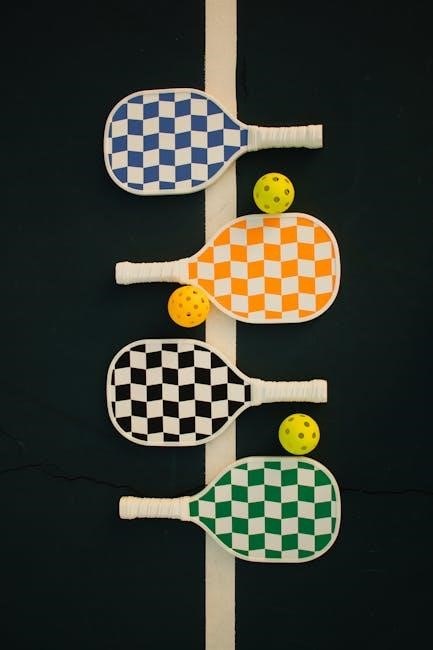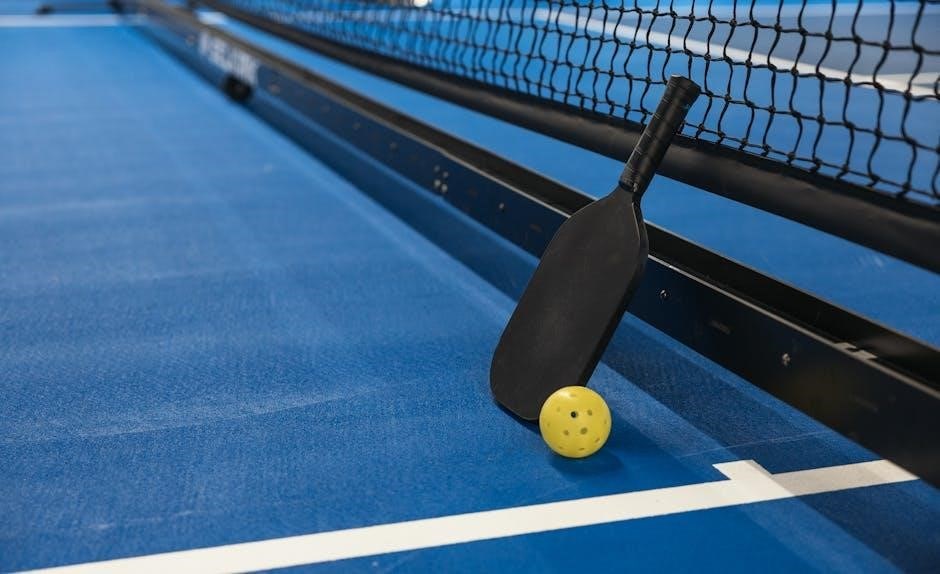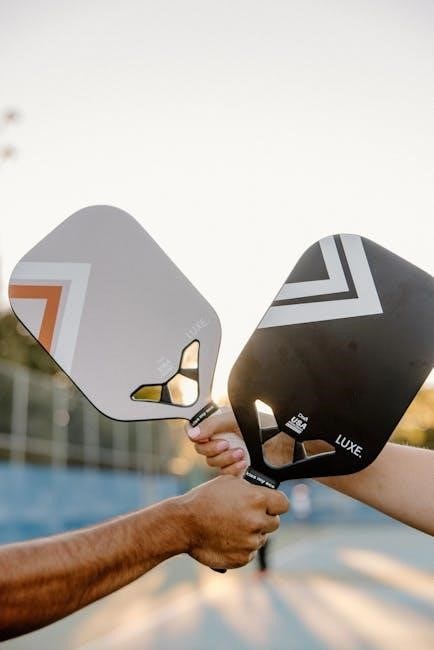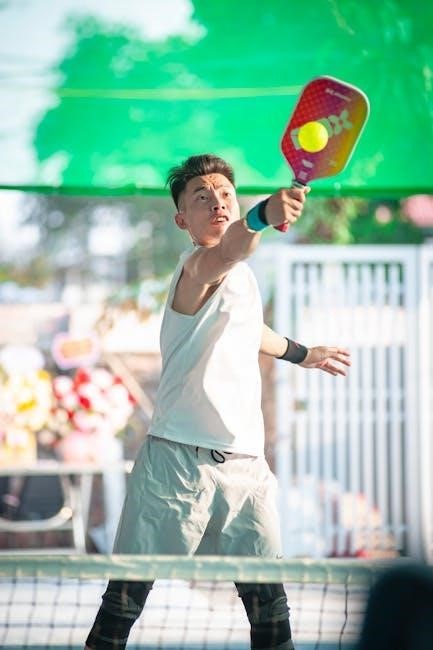Pickleball paddles are essential equipment, combining core materials like polymer with surface finishes for optimal performance. Key factors include handle length, grip size, and weight distribution to suit various playing styles and skill levels;
1.1. Understanding the Basics of Pickleball Paddles
A pickleball paddle consists of a core material, typically polymer, surrounded by a durable surface. Key components include handle length, grip size, and weight distribution. These elements influence control, power, and maneuverability. Understanding these basics helps players choose the right paddle for their style, ensuring optimal performance and enjoyment on the court.

1.2. Key Characteristics of a Pickleball Paddle
Key characteristics include core material, surface finish, handle length, grip size, weight, and shape. Polymer cores offer durability and responsiveness, while textured surfaces enhance control. Proper handle and grip size ensure comfort and maneuverability. Weight distribution affects power versus precision, and shape influences sweet spot size. These features collectively determine the paddle’s performance and suitability for different players.

Types of Pickleball Players and Their Needs
Players vary by skill level—beginners, intermediate, and advanced—each requiring specific paddle features. Beginners prioritize durability and control, while advanced players seek precision and power, influencing paddle design choices.
2.1. Paddles for Beginners
Beginners should opt for paddles with standard sizes (7 3/4″ to 8″ wide) and polymer cores for durability and performance. These paddles offer better control and predictability, ideal for learning proper techniques. They are cost-effective and designed to withstand rough play, making them perfect for those new to the sport. Testing paddles during local play can also provide insights into personal preferences.
2.2. Paddles for Intermediate Players
Intermediate players benefit from paddles with balanced weight distribution, offering enhanced control and power. They often prefer edgeless designs for larger sweet spots and improved durability. Customization options, such as grip size and handle length, allow for personalized performance.Testing different paddles during play helps intermediate players refine their style and elevate their game effectively and efficiently.
2.3. Paddles for Advanced Players
Advanced players seek high-performance paddles with precision and power. Lightweight designs with textured surfaces enhance control and spin. Customization options, such as handle length and grip size, cater to specific playing styles. Durable materials ensure longevity, while edgeless frames maximize the sweet spot. Testing paddles during play helps advanced players refine their technique and maintain peak performance in competitive settings.


Core Materials and Their Impact on Performance
Core materials like polymer, aluminum, and nomex significantly affect a paddle’s performance. Polymer cores are known for durability and a consistent feel, making them a popular choice among players.
3.1. Polymer Core Paddles
Polymer core paddles are the most common choice, offering a balance of durability and playability. They provide a consistent feel and are suitable for players of all skill levels. These cores are durable and resistant to wear, making them a reliable option for both casual and competitive play. Their popularity stems from their versatility and performance.
3.2. Other Core Materials and Their Benefits
Beyond polymer, other core materials like aluminum and composite offer unique benefits. Aluminum cores provide exceptional pop and power, ideal for advanced players seeking precision. Composite cores blend materials for enhanced control and a softer feel, reducing noise. Each material caters to specific playing styles, allowing players to optimize performance based on their preferences and skill level.

Handle Length and Grip Size
Proper handle length and grip size ensure comfort and control. Longer handles suit two-handed shots, while shorter handles enhance maneuverability. Grip size impacts stroke precision and comfort.
4.1. Importance of Proper Handle Length
Proper handle length is crucial for control and comfort. Longer handles allow for two-handed shots, enhancing power and stability, while shorter handles improve agility and quick hand movements during gameplay. Ensuring the handle fits your grip and style prevents discomfort and potential injury, making it a vital consideration when selecting a pickleball paddle.
4.2. How to Choose the Right Grip Size
Choosing the right grip size ensures comfort and control. A properly sized grip allows for a firm hold without constriction. Measure by placing your index finger between your palm and the grip; it should fit snugly. Standard sizes range from 4 to 5 inches. Test different grips if possible, considering thickness, material, and texture for optimal performance and comfort during play.
Surface Material and Finish
Surface material and finish significantly impact playability. Textured surfaces enhance spin control, while smooth finishes maximize ball speed. Durable materials like graphite or fiberglass ensure longevity and consistent performance.
5.1. Common Surface Materials for Paddles
Common surface materials for pickleball paddles include graphite, fiberglass, and composite blends. Graphite offers durability and pop, while fiberglass provides a softer touch. Textured finishes enhance spin control, and smooth surfaces maximize speed; Durable materials ensure longevity and consistent performance, catering to various playing styles and preferences for optimal gameplay.
5.2. Textured vs. Smooth Surfaces
Textured surfaces on pickleball paddles enhance spin control and provide better grip for precise shots. Smooth surfaces, while less common, reduce friction for faster ball movement. Players preferring spin and control often choose textured options, while those prioritizing speed may opt for smooth surfaces. The choice depends on personal play style and the desired performance characteristics for optimal gameplay.

Weight Distribution and Balance
Weight distribution affects maneuverability and power, with lighter paddles offering better control and heavier ones delivering more strength. Balance influences overall playability and stamina during extended games.
6.1. Light vs. Heavy Paddles
Light paddles (7.5-9 oz) enhance agility and accuracy, ideal for quick plays. Heavy paddles (9.5-12 oz) boost power, often preferred by advanced players. Choosing between them depends on your strength, skill level, and playing style—lighter for speed, heavier for might.
6.2. Edgeless vs. Edged Paddles
Edgeless paddles offer a larger hitting surface and reduced drag, ideal for precise shots and spin. Edged paddles have a protective bumper, enhancing durability but adding weight. Edgeless suits control-focused players, while edged paddles are better for power hitters seeking longevity and impact resistance.

Shape and Size Considerations
Pickleball paddles vary in shape and size, with standard dimensions offering balance and portability, while oversized options provide more reach but may compromise control for some players.
7.1. Standard vs. Oversized Paddles
Standard paddles measure 7.75-8 inches wide, offering balance and portability. Oversized paddles exceed 8 inches, providing more reach but potentially reducing control. Beginners often prefer standard sizes for maneuverability, while experienced players may opt for oversized paddles to cover more court area. Choose based on skill level and playing style for optimal performance and comfort during games.
7.2. Paddle Thickness and Its Effects
Pickleball paddles vary in thickness, typically ranging from 0.5 to 0.75 inches. Thicker paddles offer durability and power, while thinner ones provide better control and touch. Thicker paddles suit power players, while thinner options are ideal for those prioritizing precision and finesse. Thickness impacts performance, so choose based on your playing style and preferences for optimal results on the court.

Budget and Warranty
Pickleball paddles vary in price, catering to all budgets. Warranty coverage ensures durability, protecting investments. Choose wisely to balance cost and quality for long-term satisfaction and performance.
8.1. Price Ranges for Pickleball Paddles
Pickleball paddles range from entry-level options under $50 to high-end models over $300. Mid-range paddles, priced between $50 and $150, offer balanced quality and affordability. Premium paddles, often $150+, feature advanced materials and technology. Budget-friendly choices are ideal for beginners, while seasoned players may invest in higher-priced, durable options for enhanced performance and longevity.
8.2. Importance of Warranty and Durability
A durable pickleball paddle ensures longevity and consistent performance. Look for paddles with sturdy core materials and high-quality surfaces. A good warranty, typically ranging from 1 to 5 years, protects against defects and damage. Investing in a durable, warranted paddle provides peace of mind and maximizes your investment, allowing you to focus on improving your game without equipment concerns.

Additional Features and Accessories
Customization options, such as personalized designs, and accessories like covers or bags, enhance your pickleball experience. Testing paddles before purchase ensures the best fit for your style and preferences.
9.1. Customization Options for Paddles
Custom pickleball paddles offer personalized designs, allowing players to choose colors, graphics, and even names. Brands like Dink USA provide tools to design your own paddle, ensuring a unique look. Customization can also extend to handle wraps and grip sizes, catering to individual preferences. This feature is ideal for players seeking both style and functionality.
9.2. Testing Paddles Before Purchase
Testing pickleball paddles before buying is crucial to ensure they suit your style. Many players try paddles during Open Play sessions, as others often share their gear. Some manufacturers offer demo programs, allowing you to test paddles for a short period. This hands-on experience helps assess weight, balance, and feel, ensuring the paddle meets your needs and enhances your game performance effectively.